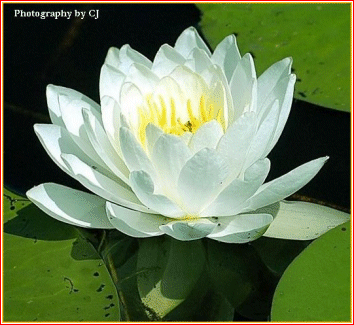

Nymphaea-Water
Lily
Compiled and edited
by Ivor Hughes
USD 1926 Part II
N.B Part 2 of the USD 1926 is given over to those drugs which although not official were widely used.
Nymphaea.- The terms water lily, or pond lily, are popularly applied to two genera of the Fam. Nymphaeaccae of which several species have been used more or less in medicine.
These are aquatic perennial herbs with thick horizontal rootstocks and usually floating leaves and solitary showy flowers. The petals are numerous; in the Nymphaea small and stamen-like, in the Castalia large and white but gradually passing into stamens.
Castalia odorata (Dryand.) Woody, and Wood (Nymphaea odorata Ait.) is popularly called Sweet scented Water lily, Water Nymph or Water Cabbage. It has large flowers which are deliciously fragrant; the numerous white petal, sometimes tinted with rose, afford an attractive contrast with the bright yellow of the stamens.
The orbicular or reniform floating leaves are from four to twelve inches in diameter, green and shining above, purplish beneath. The plant grows in ponds and sluggish streams throughout the eastern United States.
The root contains, according to Bigelow, large amounts of tannic and gallic acid. It was formerly used as an astringent in application in sore-throat and leucorrhea, also internally in diarrhea.
The dose employed in the latter condition was about thirty grains (2 Gm.).
Castalia alba. Presl. (Nymphoea alba L.), the European white water lily, was formerly official in the French Codex under the name of Nenuphar blanc. The root (Rhizoma Nymphaeae) contains, according to Gruning (A.J. Pharm., 1882), an alkaloid closely related to nupharine (see below) and several astringent principles including nymphea-tannic acid. It was used not only as an astringent but was at one time supposed to possess anaphrodisiac properties.
The flowers of this species were also recognized by the Codex. They are astringent and apparently also sedative, and were used locally in gonorrhea and leucorrhoea.
In the seeds of the Nymphoea lutea L. (I uphar luteum. Sibth. and Smith), European Yellow Pond Lily or Spatterdock, Gruning (A.J.P., 1883, 96) found an amorphous, bitter alkaloid, nupharine.
The presence of this alkaloid has been confirmed by Goris and Crete (J.Chem. S., 1910) who demonstrated its occurrence in the fresh rhizome. They assign to it the formula C18H24O2N2 The rhizome also yields a large amount of a tannin, nuphar-tannic acid, C56H56O37 This, like the previous species, was attributed with power of allaying sexual irritability and used in spermatorrhea, as well as for its astringent effects in diarrhea.
-::-
Monograph - A Modern Herbal -
Mrs. M. Grieve. F.R.H.S.
LILY, WHITE POND
Nymphaea odorata
(Soland) N.O. Nymphaeacea:
Synonyms. Sweet Water Lily. Sweet-scented
Water Lily. Water Nymph. Large White Water Lily
Part Used. The fresh root.
Description. Perennial aquatic herb, grows to the surface of the water from a thick horizontal root-stock, stem absent, flowers growing on long peduncles and the leaves on separate petioles. Stipules deltoid or nearly reniform, emarginate; leaves always floating orbicular, smooth, and shining, dark green above, wine color beneath.
Flowers large white, showy and fragrant, often 6 inches n diameter; sepals four elliptical scaphoid, nearly free; petals numerous; stamens indefinite; ovary large globular, depressed, eighteen to twenty-four-celled. Fruit a depressed globular, fleshy body; seeds oblong, stipulate. The flowers open as the sun rises, after a few hours gradually closing, being entirely closed during the midday heat and at night.
Constituents. The roots contain tannin, gallic acid and mucilage, starch, gum, resin, sugar, ammonia, tartaric acid, fecula, etc.
Medicinal Action and Uses. The root is astringent, demulcent, anodyne, and anti-scrofulous, used in dysentery, diarrhoea, gonorrhoea, and leucorrhoea externally.
The leaves and roots have been used in form of poultice to boils, tumours, scrofulous ulcers and inflamed skin; the infusion is used as a gargle for ulcers in the mouth and throat.
Dosage. The powdered root, 1/2 drachm. Infusion up to 2 fluid ounces.
The virtues of the root are quickly imparted to water. A poultice of leaves and roots relieves boils, tumours, ulcers, and inflamed skin. A complete cure of uterine cancer by a decoction and a vaginal injection is recorded.
The dose of the powdered root is 1/2 drachm in milk or sweetened water; but the best form is an infusion of 1 oz. in a pint of boiling water, macerated for thirty minutes, of which 2 to 4 fluid ounces may be given three or four times a day.
The European Yellow Pond Lily (Nuphar Advena or Nuphar luteum - Spatterdock or Frog-lily) may be used as a substitute. It contains much nuphar-tannic acid.
![]()